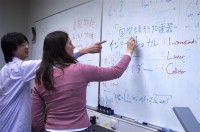 |
 |
|||||||||||||
|
|||||||||||||
|
|||||||||||||
|
Scientists are a self-organised and democratic lot. As such, they like bottom-up approaches: ask everybody involved, test all options and find the best and most logical consensus. The most recent example of this approach is the cooperation between the two detector concepts the Large Detector Concept and the Global Large Detector. Starting from first ideas during LCWS in Hamburg this summer, the two groups decided to combine their concepts into one and write a common Letter of Intent. “It just seemed logical” says Ties Behnke, one of the leaders of the LDC concept. “The two concepts are similar in many aspects, and together we can bundle more resources.” They have similar concepts for different sub-detectors, for example, and scientists from both concepts have been working together for a long time on such collaborations as CALICE and the Linear Collider-Time Projection Chamber. “The most obvious overlap is the central tracker TPC which is common to both the GLD and LDC, and being developed by both together. Also, both have silicon trackers inside or outside the TPC," says Hitoshi Yamamoto, one of the GLD leaders. Both GLD and LDC have different strengths. The GLD detector is larger and will thus better able to separate clusters in calorimeters that are good for the particle flow algorithm desired by both. While the LDC, for example, has a more sophisticated electromagnetic calorimeter. “We will be performing intensive studies to find the optimal point between them,” says Yamamoto. The combined concept has a name, too - ILD, for International Large Detector Concept. However, this name is only supposed to be preliminary until the time the Letter of Intent has been submitted and the Engineering Design Report phase is over. The two concepts see themselves as two groups working together towards the same goal, but not yet as a collaboration. “The primary new merits of the cooperation are in detector optimisation and in engineering,” says Yamamoto. R&D efforts on different detector technologies will continue and the concept remains open to new suggestions. What will not come out of the Letter of Intent is the final image of a detector and its technologies set in stone. “It will have open options because the existing sub-detector development work is happening on longer timescales,” says Behnke. While the Letter of Intent is due to be delivered to the ILC Steering Committee in about one year, the CALICE programme, for example, runs at least until 2010. The outcome of these letters is supposed to be the proof, supported by test results, that the groups can meet their own expectations. Take the concept of particle flow, for example. The cost is part of the concept, and the detector must in fact be built the way is it presented. Engineers will play a major role in this last aspect. -- Barbara Warmbein |
|||||||||||||
| © International Linear Collider |
